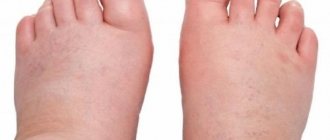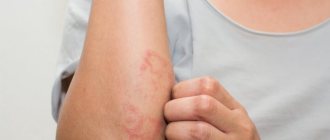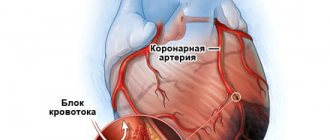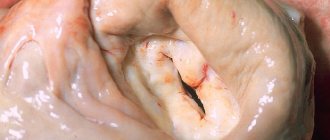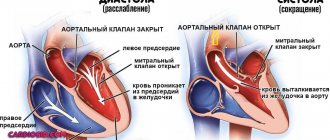What is orthostatic hypotension?
Orthostatic hypotension is a pathological syndrome that is characterized by a sudden decrease in blood pressure due to a change in body position - rising from horizontal (lying or sitting) to vertical (standing).
Directly related to decreased tone of the veins of the lower extremities. In this case, blood under the influence of gravity accumulates in the vessels of the lower extremities. Venous return to the heart, and then stroke volume, decreases, which leads to a decrease in pressure. Due to this phenomenon, cerebral blood flow is significantly reduced, which explains the symptoms of orthostatic hypotension:
- severe sudden weakness;
- flickering of spots, fogginess and darkening in the eyes;
- dizziness;
- syncope (fainting);
- noise, pulsation in the ears;
- nausea;
- rapid heartbeat (tachycardia).
With prolonged fainting, due to oxygen starvation of the brain, convulsions and dysfunction of the pelvic organs may appear. It is not uncommon for a person to suffer a traumatic brain injury due to a fall. In this case, even after the return of consciousness, some symptoms do not disappear (headache, nausea). In patients with coronary heart disease, orthostatic collapse can provoke an attack of angina, which is also associated with impaired blood supply to the myocardium.
Externally, upon examination, you can detect such signs as pale skin, increased sweating. Most often, the condition occurs in the morning, after sleep, during prolonged standing in a stuffy room or in transport in the heat. If a person loses consciousness, they may experience short-term amnesia.
Depending on the severity and frequency of attacks, there are three degrees of orthostatic hypotension:
- I Art. (mild) – rare episodes with a complete absence of fainting;
- II Art. (moderate) – episodes are more frequent, fainting may occur;
- III Art. (severe) – almost every case ends in loss of consciousness.
If such a condition passes quickly and occurs only occasionally, this is considered a variant of the norm. This often happens during adolescence, when different organ systems develop unevenly.
However, if this syndrome occurs frequently, the manifestations do not disappear after 1-2 minutes, which may be a sign of pathological disorders in the body.
Postural orthostatic tachycardia syndrome
Postural orthostatic tachycardia syndrome (POTS) was first described in 1993. However, despite its nearly 30-year history, the diagnosis and treatment of POTS still pose challenges.
So, firstly, it is not entirely clear how to classify patients who have POP syndrome in combination with any disease. Another problem is the lack of awareness among doctors about clear criteria for POT, which imply not only an excessive increase in heart rate (HR) in a standing position, but also clinical manifestations. In addition, there are practically no specific proven methods for treating POT. All these factors served as the basis for the development by experts of the Canadian Society of Cardiology of a consensus document on the diagnosis and management of patients with POP [1].
A significant difference from previously issued recommendations [2,3] is the creation of a new classification of diseases associated with the development of orthostatic intolerance. It included: POTS syndrome, POTS plus, postural symptoms without tachycardia, postural symptoms without tachycardia plus, and postural tachycardia due to another cause.
POTS syndrome
is a sustained increase in heart rate >30 beats/min in adults (over 19 years of age) and >40 beats/min in children/adolescents (under 19 years of age) when moving from a lying position to a standing position, lasting for 10 minutes in absence orthostatic hypotension (decrease in systolic blood pressure >20 mm Hg or diastolic blood pressure >10 mm Hg). In addition, the presence of such clinical criteria as dizziness, palpitations, tremor, chest discomfort, etc. is mandatory. Hemodynamic disorders and symptoms must be detected for more than 3 months. Thus, the definition is fully consistent with that of the consensus document of the American Society [2], which studies diseases of the autonomic system.
POTS plus syndrome.
In this case, the patient has all the hemodynamic and symptomatic criteria for POPT, but also has additional symptoms not related to the cardiovascular system, which often cause greater discomfort to the patient (problems associated with gastric emptying, intractable vomiting, severe constipation, neurogenic bladder , severe chronic pain syndrome, severe headaches, symptoms of anaphylaxis and food intolerance). Patients with POTS plus syndrome may have an additional disease: Ehlers-Danlos syndrome, hypermobility, celiac disease, autoimmune diseases, chronic migraine, etc.
Postural symptoms without tachycardia.
This diagnosis is appropriate in the absence of hemodynamic criteria for POT, but the presence of symptoms. Moreover, hemodynamic criteria for POP are often added to the symptoms later.
Postural symptoms without tachycardia plus.
Similar to the previous one, such patients have symptoms, but no hemodynamic manifestations of POPT and, in addition, any non-cardiovascular disease.
Postural tachycardia associated with another cause.
Such patients have hemodynamic criteria for POP, but, unlike true POP syndrome, they have a known cause of orthostatic tachycardia. It can be: acute hypovolemia, endocrinopathy, anemia, panic attacks, side effects of medications, drugs, prolonged or constant lying down.
Next, the authors of the document cover in detail the diagnosis and treatment of POP. Thus, the importance of a high-quality history and physical examination is noted (orthostatic tests must be performed, as well as an electrocardiogram recording). Moreover, this is often enough to judge the POTS syndrome. When collecting anamnesis, it is recommended to dwell in detail on the factors contributing to the appearance of symptoms, their severity, as well as the nature of nutrition (especially salt and water consumption). It is also important what medications the patient takes: for example, alpha-blockers, calcium channel blockers, serotonin reuptake inhibitors, tricyclic antidepressants and phenothiazines should be taken. Additional instrumental diagnostic methods can be used: electrocardiogram monitoring, exercise testing and echocardiography. However, it is emphasized that routine performance of these tests is not recommended.
Speaking about treatment, the authors, as before [2,3], note that there are practically no specific methods of treating POTS syndrome. At the same time, its main goal should be to increase patient awareness of the syndrome, reduce the frequency and severity of symptoms (if possible, achieve remission) and, most importantly, improve the quality of life. Most often, therapy involves the use of a combination of non-pharmacological and pharmacological strategies. The first includes: discontinuation of medications, the use of which may be associated with the development of orthostatic tachycardia, increasing fluid intake (at least up to 3 liters per day) and salt (up to 10 g NaCl per day). In addition, it is possible to sleep with the head of the bed elevated, as well as the use of compression garments, which increase venous return to the heart. Moderate physical activity is recommended for all patients. Pharmacological agents that can be used for POTS syndrome are: midodrine, pyridostigmine, fludrocortisone, ivabradine, clonidine, saline. It is noted that the choice of a specific pharmacological intervention should be determined by the leading pathophysiological mechanism of the development of POPT and associated symptoms.
Thus, to summarize the above, we can conclude that there is a lot of uncertainty in the diagnosis and treatment of POP syndrome. The presented document is a good reflection of all currently existing information.
Sources:
1. Raj S, et al. Can J Cardiol. 2020;36(3):357-372.
2. Freeman R, et al. Clin Auton Res. 2011;21(2):69-72.
3. Sheidon R, et al. Heart Rhythm. 2015;12(6)e41-63.
What are the causes of the condition?
Under physiological conditions, the phenomenon occurs due to prolonged exposure to a supine position, fasting, and in high altitude conditions among climbers. Orthostatic collapse often develops during pregnancy, especially in the later stages. After childbirth, the normal state is restored.
As for the pathological causes of orthostatic hypotension, they can be as follows:
| Cardiopathology | Angina pectoris, chronic heart failure, valve defects and other structures, myocardiopathy, rhythm disturbances |
| Vascular diseases | Atherosclerosis, varicose veins of the lower extremities |
| Endocrine disorders | Diabetes mellitus, chronic adrenal insufficiency (Addison's disease), hypoglycemia due to insulin overdose |
| Neurological pathologies | Autonomic disorders, Parkinson's disease, amyloidosis, spinal cord injury, metabolic neuropathies, Shy-Drager syndrome |
| Adverse reactions from taking medications | Beta blockers, Viagra and its analogues, antidepressants, monoamine oxidase inhibitors |
| Postprandial hypotension | Blood pressure disturbances that occur after eating, especially in old age. |
| Dehydration | Both due to a decrease in water intake and as a result of an increase in consumption - due to vomiting, diarrhea, hyperhidrosis (increased sweating), blood loss; |
| Idiopathic hypotension | The exact cause cannot be determined |
Publications in the media
Orthostatic hypotension (postural hypotension) is an excessive decrease in blood pressure in an upright body position. Decrease in systolic blood pressure by more than 20 mm Hg. has clinical significance, especially in the presence of signs of presyncope or fainting conditions. Orthostatic hypotension cannot be considered an independent nosological form. This is a violation of blood pressure regulation due to various reasons.
Etiology • Drugs •• Excessive diuretic therapy, overdose of ACE inhibitors (especially in combination with early administration of large doses of diuretics), α-blockers, nitroglycerin intake (orthostatic hypotension, sometimes with a syncopal episode, can occur even when taking a single dose of nitroglycerin, especially in a standing position), levodopa drugs, phenothiazines, TAD •• It is especially necessary to take into account the possibility of orthostatic hypotension while taking antihypertensive drugs in elderly patients who have isolated systolic hypertension • Infectious diseases - febrile phase of malaria • Reduced sensitivity of baroreceptors of the aortic arch and carotid sinuses — more typical for elderly patients, especially those on bed rest for a long time • Hypovolemia and anemia due to various reasons. Bleeding and hypovolemia lead in the initial stages to a decrease in blood pressure only in an upright position, which is manifested by orthostatic hypotension • Reduced venous return: varicose veins, pulmonary embolism and cardiac tamponade • Neurological disorders affecting the autonomic nervous system - diabetic neuropathy, other neuropathies and some rare diseases spinal cord • Idiopathic orthostatic hypotension.
Clinical manifestations. Dizziness, weakness, blurred vision and other symptoms that occur in an upright position.
Diagnostics • One should remember the need to measure blood pressure in a standing position in patients who have signs of decreased blood pressure in an upright position, as well as in all elderly patients • Orthostatic test: determine heart rate, blood pressure and assess the patient’s condition after he has been in a standing position for 2 –3 min •• Decrease in systolic blood pressure by more than 20 mm Hg. indicates the presence of orthostatic hypotension, especially when combined with signs of presyncope •• Loss of muscle tone and collapse also indicate orthostatic hypotension.
Treatment • Correction of the underlying condition leading to orthostatic hypotension • Prolonged bed rest and immobilization should be avoided; if prolonged bed rest is necessary, therapeutic exercises in bed are indicated • Increased salt intake • Mineralocorticoids (the risk of developing heart failure must be remembered): the initial dose of fludrocortisone is 0.05–0.1 mg orally 1 time / day, maximum dose - 0.1 mg 2 times / day. After 1 week of therapy, the concentration of potassium ions in the blood serum should be determined.
Note. Sudden onset orthostatic hypotension suggests unrecognized MI, PE, or arrhythmia. Other causes of orthostatic hypotension or collapse during rapid transition to an upright position are aortic stenosis, cardiomyopathy, and constrictive pericarditis.
ICD-10 • I95.1 Orthostatic hypotension
How to treat?
If you witness an attack of orthostatic hypotension, you must provide first aid to the victim, which consists of the following:
- If a person has lost consciousness, sprinkle him with cold water or use ammonia (only very carefully, for example, moistening a napkin with a few drops of the solution, so as not to cause a burn to the nasal mucosa).
- When the patient returns to normal, give him warm tea with sugar.
- If consciousness does not return within one or two minutes, call an ambulance.
The following medications are used to treat manifestations of orthostatic hypotension:
- psychostimulants (caffeine preparations);
- alpha-adrenergic agonist (midodrine, etilephrine) – a hypertensive agent with a vasoconstrictor effect;
- mineralocorticoid (hydrocortisone) – helps increase circulating blood volume and constricts peripheral blood vessels.
- beta blockers (metoprolol, propranolol) – potentiate the effect of adrenal hormones;
- plant adaptogens (ginseng, eleutherococcus, lemongrass) – have a general tonic and strengthening effect on the body, increase blood pressure.
Specific therapy is also used for the specific disease that caused this syndrome.
Seizure prevention
An important part of the fight against this syndrome is prevention, which greatly reduces the frequency and severity of symptoms.
Doctors advise following the following recommendations:
- Avoid sudden changes in body position. When you wake up in the morning, lie down for a while and then slowly get up.
- If bed rest is indicated for you, take measures to combat physical inactivity. Do exercises right in bed, change your position periodically.
- If you have varicose veins, it is recommended to use compression bandages on the legs or special underwear;
- Maintain normal water balance - drink at least 1.5-2 liters of fluid per day. It is also necessary to consume enough salt.
- Walk more in the fresh air, engage in physical exercise (especially aimed at training the muscles of the legs and abdominals).
- Try not to overeat - this also provokes orthostatic collapse.
Does the presence of this condition affect the patient's overall prognosis?
It should be understood that orthostatic hypertension syndrome is not a separate disease, but usually develops against the background of one or another pathology and will always be an aggravating factor.
This condition can provoke the development of some dangerous complications. The most common are traumatic brain injuries due to falls. Another negative consequence may be encephalopathy, which occurs due to prolonged fainting, which can cause irreversible changes in the cerebral cortex, including dementia (dementia).
With proper treatment and implementation of preventive recommendations, the prognosis in most cases is favorable.
conclusions
Orthostatic hypotension, despite its apparent harmlessness, can lead to the development of dangerous complications, which, therefore, requires serious attention. If a rapid change in body position, in addition to slight dizziness or darkening of the eyes, is also accompanied by fainting, you should immediately consult a doctor for a full examination.
This condition may indicate the presence of diseases, such as pathologies of the cardiovascular system or endocrine disorders.
Postural orthostatic tachycardia (POT) is one of the variants of autonomic dysfunction, the criteria of which is an increase in heart rate by 30 beats/min or more 10 minutes after changing body position from horizontal to vertical in the absence of orthostatic hypotension (decrease in SBP by 20 mm Hg . and more). To verify this diagnosis, a tilt test is necessary. The most common mechanism of this disorder is an excessive increase in adrenergic activity when adopting a vertical body position (the formal criterion for the hyperadrenergic variant of POT is an increase in the concentration of norepinephrine by more than 600 pg/ml). POTS is often accompanied by symptoms such as palpitations, dizziness, blurred vision, decreased exercise tolerance, fatigue, shortness of breath, chest discomfort, nausea, and is also associated with vasovagal syncope, sleep disturbances, migraines, abdominal pain and other symptoms irritable bowel, dysuric disorders. Of course, POP leads to a decrease in quality of life. The prevalence of this disorder reaches 1% in the population. Quite often these are people under 50 years of age, more often women. There are no effective treatments for this condition. Beta blockers may cause hypotension and worsening depression and fatigue. Alpha-agonists, mineralocorticoids, serotonin reuptake inhibitors, or serotonin-norepinephrine reuptake inhibitors may also be prescribed, as well as lifestyle modifications such as increasing fluid intake, increasing salt intake, or wearing compression stockings. All of these methods have limitations in their effectiveness and safety.
Retrospective cohort studies, as well as individual published case reports, indicate the potential effectiveness of ivabradine for the correction of POP.
The JACC published the results of a small, randomized, placebo-controlled study with a crossover design. The study included patients aged 18-65 years with proven POP. The comparison groups consisted of 22 people. Patients with AF or other clinically significant supraventricular cardiac arrhythmias were not included. For 1 month, group 1 took ivabradine, group 2 took placebo, the patients “washed off” the drug for a week, and over the next month the groups “switched” the drug. It was shown that the use of ivabradine significantly reduced the increase in heart rate when moving to a vertical position of the body (p = 0.001), there was a tendency towards a smaller increase in norepinephrine (p = 0.056) in a vertical position, which was realized in improving the quality of life (both exercise tolerance and social aspects). No significant side effects were reported in patients taking ivabardine.
POTIs are quite often present in patients after a severe infectious disease, such as Lyme disease. This syndrome is also typical for patients who have recently had COVID-19. The study authors believe that ivabradine could also be used in patients with symptomatic POPT following COVID-19. It should be remembered, however, that taking ivabardine may increase the risk of developing AF, and this heart rhythm disorder is one of the most common cardiovascular manifestations of COVID-19 (translator's note).
Based on materials:
Taub PR, Zadourian A, Lo HC, Ormiston CK, Golshan S, Hsu JC. Randomized Trial of Ivabradine in Patients With Hyperadrenergic Postural Orthostatic Tachycardia Syndrome. J Am Coll Cardiol 2021;77:861-71.
Text: Shakhmatova O.O.


